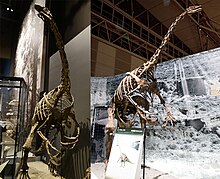
Back عظايا حاصدة Arabic Terizinosàurids Catalan Therizinosauridae Czech Therizinosauridae Spanish دروگرخزندگان Persian Therizinosauridae Finnish Therizinosauridae French Therizinosauridae Galician תריזינוזאוריים HE Therizinosauridae Hungarian
| Therizinosaurids Temporal range: Cretaceous,
~ | |
|---|---|

| |
| Mounted skeletons of Nothronychus mckinleyi and N. graffami | |
| Scientific classification | |
| Domain: | Eukaryota |
| Kingdom: | Animalia |
| Phylum: | Chordata |
| Clade: | Dinosauria |
| Clade: | Saurischia |
| Clade: | Theropoda |
| Clade: | Maniraptora |
| Clade: | †Therizinosauria |
| Superfamily: | †Therizinosauroidea |
| Family: | †Therizinosauridae Maleev, 1954 |
| Type species | |
| †Therizinosaurus cheloniformis Maleev, 1954
| |
| Genera | |
| Synonyms | |
Therizinosauridae (meaning 'scythe lizards')[1] is an extinct family of derived (advanced) therizinosauroid dinosaurs whose fossil remains have been found in mostly Late Cretaceous boundary. Even though representative fossils have only been found throughout Asia and North America, the range of Therizinosauridae is believed to have spanned much of the supercontinent of Laurasia based on several footprints and isolated remains in Europe and Africa. Currently, Therizinosauridae comprises eight described and named taxa.
Therizinosauridae was named in 1954 by paleontologist Evgeny Maleev after the large, claw-bearing unguals of the type species Therizinosaurus cheloniformis. Therizinosaurids were generally large and very robustly built animals that had a near convergent body plan with the more recent (and also extinct) ground sloths. The largest genera of the group are Therizinosaurus and Segnosaurus, which were about 10 m (33 ft) and 7 m (23 ft) long, respectively. The physiology of therizinosaurids include a broad and rounded belly supported by a wide and robust pelvis with thick hind-limbs composed of very stout, four-toed feet, a strong arm build with enhanced hand flexibility, elongated hand claws, and a highly derived, nearly avian inner-ear. Traits that are also well-known include an elongated neck, a prominent keratinous beak and a prosauropod-like dentition that differs from all theropods. In addition, therizinosaurids are estimated to have had more advanced feathers in comparison to primitive therizinosaurs (Beipiaosaurus or Jianchangosaurus).
The unique and bizarre features of the group has encouraged research into the paleobiology and paleoecology of the family. A fair portion of modern research has concentrated on the feeding-patterns of these dinosaurs, as they are considered to be the best regarded theropod candidates for herbivory. While other theropod groups are fully carnivorous, members of Therizinosauridae diverged and adopted an herbivorous and possibly omnivorous lifestyle. This is even more supported by their unusual morphology. As indicated by their feet morphology and several footprints from Asia, Africa and Europe, they probably were plantigrade walkers, but further examination may be required. Therizinosaurids were oviparous animals that nested in colonies and laid egg clutches. In fact, therizinosaur eggs are particularly common in Late Cretaceous formations, mainly in Asia. The oofamily Dendroolithidae is often attributed to therizinosaur-grade dinosaurs. Some of the first dendroolithid eggs were found on the Bayan Shireh and Nanchao formations.
Their relationships were confusing and obscure on the early years of research mainly because of the unusual traits among members. Several alternative classifications were proposed (such as the naming of Segnosauridae in 1979) until more complete specimens and other taxa were described during the 1990s, which confirmed them as theropods. Many of the shared characters within the group also showed that Segnosauridae was a junior synonym of the much earlier family Therizinosauridae. The current phylogenetic consensus is that therizinosaurids evolved from small, bird-like maniraptorans, and thus they fall within the coelurosaurian clade called Maniraptora. Moreover, most of the traits of therizinosaurids (such as the ear structure) were inherited by smaller, agile, carnivorous ancestors. Extensive phylogenetic analyses have concluded that within Maniraptora, therizinosaurs were the first of five major groups to diverge.
- ^ Maleev, E. A. (1954). "Новый черепахообразный ящер в Монголии" [New turtle like reptile in Mongolia]. Природа [Priroda] (in Russian) (3): 106−108. Translated paper.